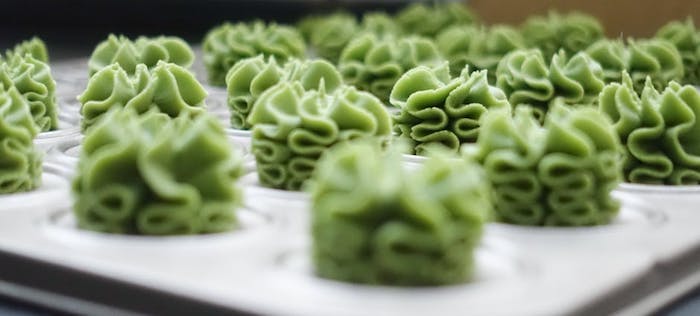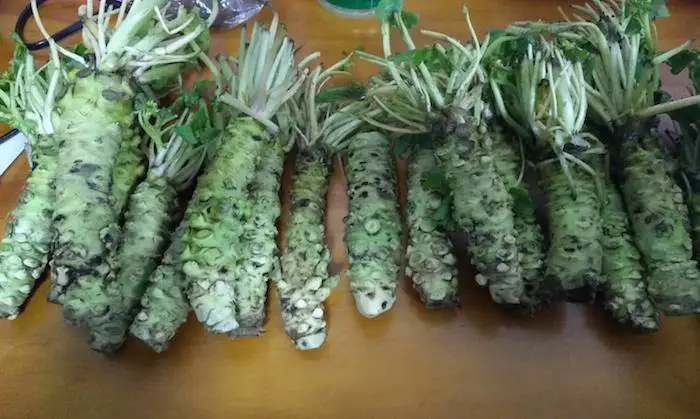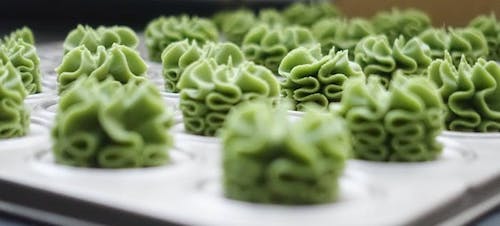We are reader supported. When you purchase through links on our site, we may earn an affiliate commission. Also, as an Amazon affiliate, we earn from qualifying purchases.

If you are a fan of Japanese cuisine, wasabi would definitely be in your vocabulary. This amazing paste gives that extra zing you are looking for when eating sushi. Wasabi is a versatile ingredient that is also used in a variety of other dishes like noodles or soup.
Yes, you can put wasabi on sushi. In restaurants, the sushi you have ordered will already have a thin layer of wasabi in between the piece of fish and rice. In Japan, additional wasabi can be added on the top of your fish. However, a lot of North Americans put the wasabi in the soy sauce.
What is Wasabi and Why is it Used?
Wasabi or Japanese Horseradish is of the mustard family, a paste is made from the rhizome which is used as a condiment in most Japanese dishes.
Sushi dishes have relatively been around for centuries, and during the times that refrigeration was not yet invented, wasabi was used to sanitize the meat from bacteria.
Back in those days, wasabi was used to avoid food poisoning. Today a series of guidelines have been in place to make sure consumers will not be infected with the possible parasites and bacteria in the fish when consuming it raw. Fishermen practice flash freezing upon catching the fish in order to kill the parasites.
According to traditional Sushi Chefs, the taste enhancement brought by wasabi was only by chance when it was first used. Today, wasabi is mainly used for the flavor it adds to the dish since there are dozens of other ways to sanitize the fish before consumption.
They have also been used medicinally prior to being used in the culinary world. The anti-oxidant and anti-bacterial properties of this root have definitely been beneficial.
Wasabi Paste versus Real Wasabi
This may come as a surprise but most wasabi pastes used in restaurants may not be made from actual wasabi rhizomes. These pastes are often made with a blend of mustard flour, horseradish extract, and food coloring. This is to make it look and somehow taste the same, but being able to eat real wasabi is quite different. It is much more aromatic and has less of a burning sensation when eaten.
Fresh wasabi paste is made right before eating because upon grating the root, the volatile substances that give off that distinct taste tend to break down in a matter of a few minutes. Wasabi tastes best when it is prepared fresh.
There are three forms of real wasabi to choose from:
1. Wasabi Rhizome

The rhizome(see my recommendation) is the most expensive form of wasabi. Due to its rarity, finding in them in a physical store would be close to impossible especially when you live outside Japan. The current rate for a kilogram of wasabi is approximately $160. If stored properly, you can keep the root viable for up to a month.
2. Wasabi Paste
Legitimate wasabi paste is found in squeeze tubes and never in sachets or plastic containers. They are shipped and sold frozen to keep fresh. Once you have started using it, it is best to keep the tube sealed and in the refrigerator. It may not be as good as the fresh rhizome, but using a legitimate paste from the wasabi rhizome is definitely better than the fake wasabi around.
3. Wasabi Powder
The powder version of wasabi is the cheapest of all three forms. It is from the roots of the wasabi plants, which have been dried and ground. Some brands would add extenders such as cornstarch to maximize your use. When mixed with a little water, the powder can be formed into a paste ready for consumption.
As mentioned due to the scarcity in plant production, real wasabi is quite expensive, which is why fake alternatives are quite popular in the market. One thing is for sure, once you have tried real wasabi, the fake ones will never taste the same.
How to Prepare Fresh Wasabi?
In the event you do get your hands on a fresh wasabi rhizome, here are the steps you can follow in order to make fresh homemade wasabi for your sushi.
1. Selection
Choose a firm rhizome with crisp leaves. Rhizomes at this state are at its prime and would give the best flavor. Soft roots are close to rotting and would not be good to use.
2. Cut the Leaves
The leaves are not really used in sushi, but they can be used in salads. You can opt to create an appetizer from them.
3. Wash and Peel
Wash the wasabi and peel a portion of the rhizome. Be sure to only peel the part you will be using for the dish. Keeping the skin intact will make it last longer and avoid it from rotting.
4. Grate
You can opt to use graters like this to form the paste, but the best grater to use is an Oroshigane or a sharkskin grater. The rough surface on the sharkskin grater is ideal in breaking down the wasabi allowing it to release its flavor fully without getting huge chunks in the paste. Using this grater gives you a smoother result. To grate, all you need to do is move the root in a circular motion until the desired amount is made.
5. Serve
Once you have grated enough wasabi, you may scrape it off the grater and serve as an additional condiment or spread onto your sushi. It is important to consume the grated wasabi within 20 minutes. Letting it stand out longer will definitely decrease its flavor potential.
6. Store
Since only a small amount of wasabi will be used at a time, the root must be stored properly in order for it to last longer. The secret to keeping the roots in viable condition is hydration. Wrap them in damp towels and store them in your refrigerator. These roots can last up to 30 days in when kept properly.
Premium fresh wasabi has a totally different taste compared to what we’re often used to. Its flavor is less spicy and more aromatic, giving any dish that extra kick without compromising the original flavor, but rather complementing two different ones.
Related Article: How Much Does A Wasabi Root Weigh?
What is the Correct Way of Placing Additional Wasabi?
As we mentioned earlier, professional chefs who are experienced in Japanese cuisine would place a layer of wasabi in between the rice and meat of their sushi. If fresh wasabi is used, this would often be enough, but since most restaurants use wasabi paste or powder, we would often add more.
The Japanese people are very concise about how they eat their food. When consuming sushi with a Japanese, things we normally do would be frowned upon. When adding wasabi to your sushi, here are a few things you need to know:
1. Use in Moderation
Since there is already a layer of wasabi within the sushi, you would only need a tiny bit more. Use your chopstick and get a small amount and spread across the meat of your sushi.
2. Never Mix with Soy Sauce
It is quite common for foreigners to drown their wasabi in the soy sauce. This is not acceptable in Japanese culture. Mixing wasabi in the soy sauce will destroy the original flavor of the wasabi. Spread a bit over the meat and then dip your sushi (meat end first) in the soy sauce.
Related Article: Why Do You Eat Wasabi With Sushi?
Other Benefits of Wasabi
Aside from being a condiment, the Japanese people have been using wasabi for medical purposes as well. The active agent of wasabi called isothiocyanates contributes to its antioxidant properties, this is also the source of the wasabi’s unique flavor. Here are a few of the health benefits of wasabi:
1. Lower Risk of Cancer
Studies have shown that the consumption of wasabi inhibits the growth of pancreatic, skin and breast cancer cells. The active agent, isothiocyanate, along with a hexyl group is able to suppress the malignant growths.
2. Improve Cardiovascular Health
The same active agent also lessens platelet aggregation, making your blood less thick. When this happens red blood cells will not clump together to form clots which are the main causes of strokes and other possible cardiovascular issues.
3. Reduces Inflammation
Isothiocyanates also help manage inflammation in the body through the inhibition of various inflammatory markers such as cytokines.
4. Fights Bacteria
As discussed earlier, we have learned that wasabi was actually used to kill bacteria when sushi was consumed centuries ago. This is proof of its anti-bacterial properties. There have been several studies published under the Journal of Food Microbiology showing that wasabi was effective in killing Helicobacter pylori, bacteria responsible for severe digestive tract infections.
5. Improve Digestive Health
Wasabi is able to control blood sugar through regulation of your stomach’s digestion of carbohydrates. Since it also contains fiber, you feel full longer and in turn, reduce binge eating during one meal.
Wasabi is truly a diverse ingredient capable of many things than just flavor. With its medicinal properties and great flavor, you are sure to enjoy your next sushi dinner with these facts.

